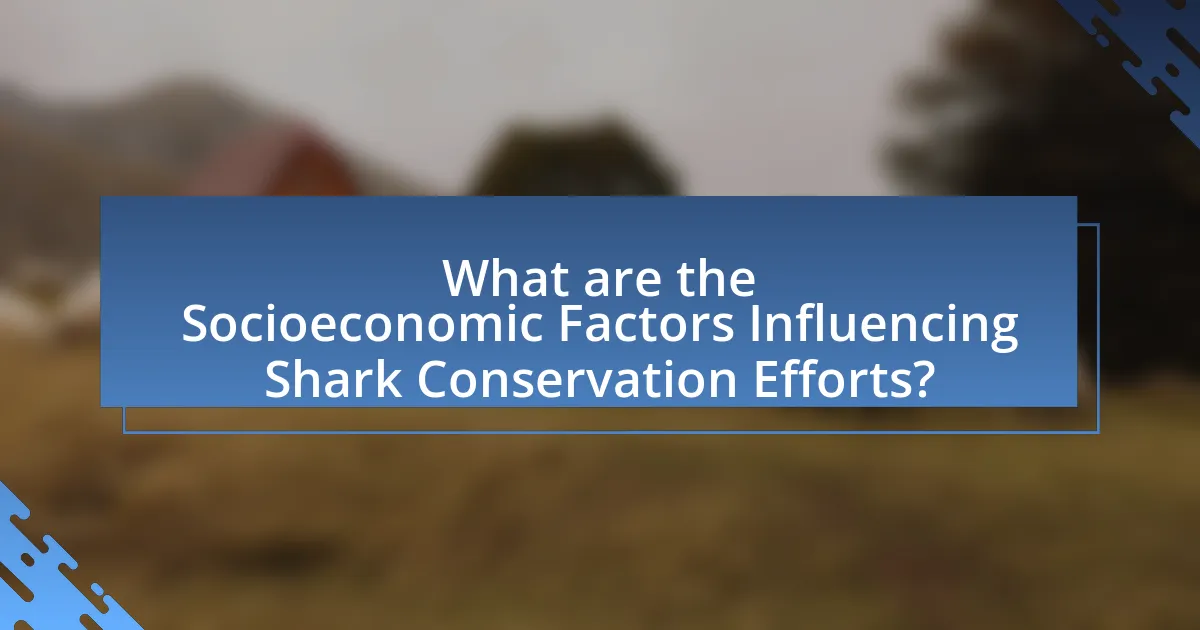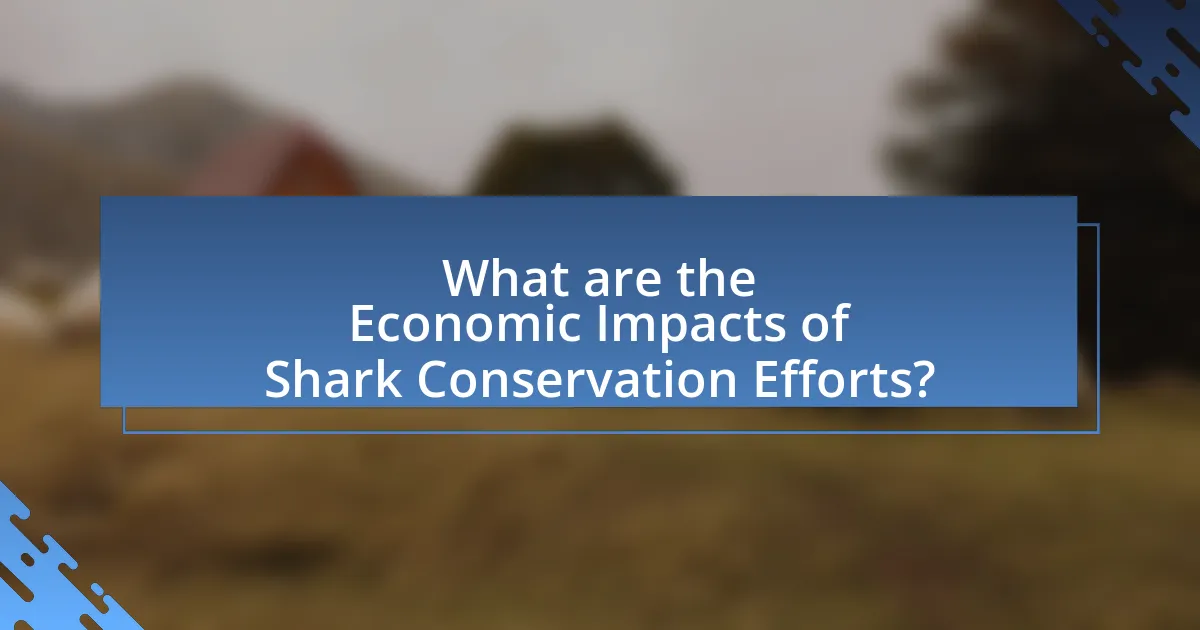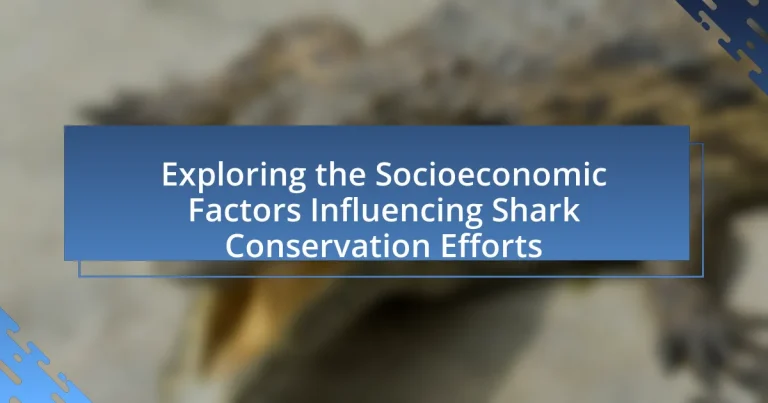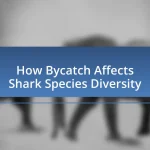The article examines the socioeconomic factors that influence shark conservation efforts, highlighting the interplay between local community reliance on fishing, economic incentives for sustainable practices, and the impact of tourism revenue from shark-related activities. It discusses how economic conditions affect funding and public support for conservation initiatives, the role of community engagement and education in fostering conservation success, and the significance of cultural attitudes towards sharks. Additionally, the article explores the effectiveness of policies and governance in shaping conservation strategies, the economic benefits of healthy shark populations, and best practices for enhancing conservation efforts through community involvement and education.

What are the Socioeconomic Factors Influencing Shark Conservation Efforts?
Socioeconomic factors influencing shark conservation efforts include local community reliance on fishing, economic incentives for sustainable practices, and tourism revenue from shark-related activities. Communities that depend on fishing often prioritize immediate economic needs over conservation, leading to overfishing and habitat destruction. Conversely, regions that benefit from ecotourism, where sharks attract tourists, may adopt conservation measures to protect their marine ecosystems, as evidenced by studies showing that shark diving can generate significant income, such as the $220 million annually in the Bahamas from shark tourism. Additionally, education and awareness programs can shift public perception, fostering support for conservation initiatives, as seen in various successful campaigns worldwide.
How do economic conditions affect shark conservation initiatives?
Economic conditions significantly influence shark conservation initiatives by determining funding availability and public support. When economic conditions are strong, governments and organizations are more likely to allocate resources towards conservation efforts, as seen in countries with robust economies that have successfully implemented marine protected areas. Conversely, during economic downturns, funding for conservation projects often decreases, leading to reduced enforcement of regulations and increased illegal fishing activities. For instance, a study published in the journal “Conservation Biology” found that economic recessions correlate with a decline in conservation funding, which negatively impacts shark populations and their habitats. Thus, the state of the economy directly affects the effectiveness and sustainability of shark conservation initiatives.
What role does funding play in shark conservation efforts?
Funding is crucial for shark conservation efforts as it enables research, habitat protection, and enforcement of regulations. Financial resources support scientific studies that assess shark populations and their ecosystems, which are essential for informed conservation strategies. For instance, the Global Environment Facility has invested over $1 billion in marine biodiversity projects, including shark conservation, demonstrating the impact of funding on preserving these species. Additionally, funding facilitates community engagement programs that promote sustainable fishing practices, further enhancing conservation outcomes.
How do local economies impact the prioritization of shark conservation?
Local economies significantly influence the prioritization of shark conservation by determining the financial incentives and resources available for conservation efforts. When local communities rely on fishing, particularly shark fishing, for their livelihoods, the economic benefits of harvesting sharks often outweigh the perceived benefits of conservation. For instance, in regions where shark tourism generates substantial revenue, such as in the Bahamas, local economies may prioritize shark conservation to sustain tourism income, which can be more lucrative than fishing. Conversely, in areas where fishing is the primary economic activity, the immediate financial gain from shark catches can lead to reduced conservation efforts. Studies have shown that regions with strong economic ties to marine tourism tend to implement more effective shark conservation policies, highlighting the direct correlation between local economic structures and conservation priorities.
What social factors contribute to the success of shark conservation?
Community engagement and education are critical social factors that contribute to the success of shark conservation. When local communities are actively involved in conservation efforts, they are more likely to support and participate in initiatives that protect shark populations. For instance, educational programs that raise awareness about the ecological importance of sharks can foster a sense of stewardship among community members. Research indicates that regions with strong community involvement in conservation efforts see higher compliance with regulations and better outcomes for shark populations. A study published in the journal “Conservation Biology” highlights that community-led initiatives in places like the Bahamas have led to significant increases in shark populations, demonstrating the effectiveness of social engagement in conservation strategies.
How does public awareness influence conservation policies?
Public awareness significantly influences conservation policies by shaping public opinion and driving political action. When the public is informed about the importance of conservation, particularly regarding endangered species like sharks, there is often increased pressure on policymakers to implement protective measures. For instance, studies have shown that heightened awareness campaigns can lead to a rise in support for legislation aimed at shark conservation, such as bans on shark finning. According to a survey conducted by the Pew Charitable Trusts, 70% of respondents supported stronger protections for sharks after being educated about their ecological role and the threats they face. This demonstrates that informed public sentiment can directly translate into legislative action, thereby enhancing conservation efforts.
What is the impact of community involvement on conservation efforts?
Community involvement significantly enhances conservation efforts by fostering local stewardship and increasing public awareness. Engaged communities are more likely to participate in conservation activities, such as habitat restoration and species monitoring, which directly contribute to the success of conservation initiatives. For instance, a study published in the journal “Conservation Biology” found that community-led conservation projects in coastal areas led to a 30% increase in local fish populations, demonstrating the effectiveness of local engagement in marine conservation. Additionally, when communities are involved, they often advocate for sustainable practices, leading to long-term ecological benefits and improved livelihoods.
Why are cultural attitudes significant in shark conservation?
Cultural attitudes are significant in shark conservation because they directly influence public perception and behavior towards sharks. Positive cultural attitudes can lead to increased support for conservation initiatives, while negative attitudes may result in fear and hostility towards sharks, hindering conservation efforts. For instance, in regions where sharks are revered in local traditions, communities are more likely to engage in protective measures, as seen in places like the Pacific Islands, where cultural beliefs promote the protection of sharks as ancestral guardians. Conversely, in areas where sharks are viewed as threats, such as in some coastal communities, this can lead to overfishing and a lack of support for conservation policies. Therefore, understanding and addressing cultural attitudes is essential for effective shark conservation strategies.
How do cultural beliefs shape perceptions of sharks?
Cultural beliefs significantly shape perceptions of sharks by influencing how communities view their role in the ecosystem and their relationship with humans. For instance, in some cultures, sharks are revered as symbols of strength and protection, leading to a more positive perception and greater conservation efforts. Conversely, in cultures where sharks are associated with danger and aggression, such as in many Western societies, fear and negative stereotypes prevail, resulting in harmful attitudes towards sharks and reduced conservation initiatives. Research indicates that these cultural narratives can directly impact policy decisions and community engagement in shark conservation, as seen in the Pacific Islands, where traditional beliefs promote the protection of sharks, contrasting with regions where sharks are often demonized.
What role do traditional practices play in conservation strategies?
Traditional practices play a crucial role in conservation strategies by integrating local knowledge and cultural values into environmental management. These practices often promote sustainable resource use, as seen in many coastal communities where traditional fishing methods are designed to maintain fish populations and protect marine ecosystems. For instance, the use of seasonal closures and specific fishing gear, rooted in indigenous knowledge, has been shown to enhance biodiversity and support shark conservation efforts. Studies indicate that communities employing traditional ecological knowledge can achieve better conservation outcomes, as they align conservation goals with local customs and livelihoods, fostering community engagement and compliance with conservation measures.

How do Policy and Governance Affect Shark Conservation Efforts?
Policy and governance significantly influence shark conservation efforts by establishing regulations that protect shark populations and their habitats. Effective policies, such as fishing quotas and marine protected areas, help mitigate overfishing and habitat destruction, which are critical threats to sharks. For instance, the implementation of the Shark Conservation Act in the United States has led to a reduction in shark finning, thereby supporting population recovery. Additionally, international agreements like the Convention on International Trade in Endangered Species (CITES) regulate the trade of endangered shark species, promoting global cooperation in conservation. These governance frameworks are essential for ensuring sustainable practices and fostering community engagement in conservation initiatives.
What policies are currently in place for shark conservation?
Current policies for shark conservation include international agreements such as the Convention on International Trade in Endangered Species of Wild Fauna and Flora (CITES), which regulates trade in shark species listed as threatened. Additionally, regional fisheries management organizations (RFMOs) implement measures to manage shark populations, including catch limits and bans on shark finning. For instance, the Western and Central Pacific Fisheries Commission (WCPFC) has established guidelines to protect vulnerable shark species. These policies are supported by scientific assessments that highlight the declining populations of many shark species, emphasizing the need for effective conservation measures.
How effective are international agreements in protecting shark populations?
International agreements are moderately effective in protecting shark populations, as they establish frameworks for cooperation and conservation among countries. For instance, the Convention on International Trade in Endangered Species of Wild Fauna and Flora (CITES) regulates trade in shark species, leading to increased awareness and some reductions in illegal fishing. However, enforcement remains a challenge, with only 20% of shark species currently protected under international agreements, according to the International Union for Conservation of Nature (IUCN). Additionally, regional fisheries management organizations (RFMOs) have made strides in managing shark catches, but compliance varies significantly among member states. Overall, while international agreements provide essential guidelines and promote conservation efforts, their effectiveness is often hindered by inconsistent enforcement and varying levels of commitment from countries.
What local regulations are most impactful for shark conservation?
Local regulations that are most impactful for shark conservation include bans on shark finning, restrictions on fishing quotas, and the establishment of marine protected areas (MPAs). Bans on shark finning prevent the wasteful practice of removing fins and discarding the rest of the shark, which has been shown to significantly reduce shark mortality rates. For instance, countries like the United States and Australia have implemented such bans, leading to improved shark populations in certain regions. Restrictions on fishing quotas help manage shark populations by limiting the number of sharks that can be caught, thereby allowing for population recovery. Additionally, the establishment of MPAs creates safe havens for sharks, protecting them from fishing and habitat degradation. Research indicates that MPAs can lead to increased shark abundance and biodiversity, as seen in the Bahamas where MPAs have resulted in a 200% increase in shark populations.
How does governance influence conservation funding and resources?
Governance significantly influences conservation funding and resources by establishing policies, regulations, and frameworks that dictate how financial resources are allocated and managed. Effective governance can lead to increased funding through the creation of incentives for private investment and international cooperation, as seen in initiatives like the Convention on Biological Diversity, which encourages countries to commit financial resources for conservation efforts. Conversely, poor governance can result in misallocation of funds, lack of transparency, and reduced public trust, ultimately hindering conservation initiatives. For example, countries with strong governance structures often receive more funding from international organizations, as they demonstrate accountability and effective management of resources, which is crucial for successful conservation outcomes.
What are the challenges in securing government support for shark conservation?
Securing government support for shark conservation faces several challenges, primarily due to competing economic interests, lack of public awareness, and insufficient scientific data. Competing economic interests arise from industries such as fishing and tourism, which may prioritize short-term profits over long-term conservation efforts. For instance, in regions where shark fishing is economically significant, governments may hesitate to impose restrictions that could impact local livelihoods. Additionally, a lack of public awareness about the ecological importance of sharks contributes to minimal pressure on governments to act. Research indicates that many communities do not recognize sharks’ roles in maintaining marine ecosystems, leading to lower advocacy for their protection. Furthermore, insufficient scientific data on shark populations and their ecological roles can hinder effective policy-making, as governments may lack the necessary information to justify conservation measures.
How can policy changes enhance conservation efforts?
Policy changes can enhance conservation efforts by establishing stricter regulations and protections for endangered species, thereby reducing illegal fishing and habitat destruction. For instance, the implementation of marine protected areas (MPAs) has been shown to increase fish populations and biodiversity, as evidenced by a study published in the journal “Nature” which found that MPAs can lead to a 20-50% increase in fish biomass within their boundaries. Additionally, policies that promote sustainable fishing practices can help balance economic needs with ecological preservation, ensuring long-term viability of marine ecosystems.
What role do NGOs play in shaping conservation policies?
NGOs play a crucial role in shaping conservation policies by advocating for environmental protection, influencing legislation, and mobilizing public support. They conduct research that informs policymakers about the ecological impacts of various practices, such as overfishing and habitat destruction, which are particularly relevant to shark conservation. For instance, organizations like the Shark Trust and Oceana have successfully lobbied for stronger regulations on shark fishing and trade, leading to the implementation of protective measures in several countries. Their efforts often result in increased awareness and engagement from local communities, which is essential for the sustainable management of marine resources.
How do NGOs collaborate with governments for effective conservation?
NGOs collaborate with governments for effective conservation by engaging in partnerships that leverage resources, expertise, and community outreach. These collaborations often involve joint initiatives, such as developing conservation policies, conducting research, and implementing on-the-ground projects that protect ecosystems. For instance, the World Wildlife Fund (WWF) has worked with various governments to establish marine protected areas, which are crucial for shark conservation. This partnership approach enhances the effectiveness of conservation efforts by combining the scientific knowledge of NGOs with the regulatory power of governments, leading to more comprehensive and enforceable conservation strategies.
What successes have NGOs achieved in shark conservation?
NGOs have achieved significant successes in shark conservation by implementing effective policies and raising awareness. For instance, organizations like Oceana and the Shark Trust have successfully advocated for the establishment of marine protected areas (MPAs), which have been shown to increase shark populations by providing safe habitats. Research indicates that MPAs can lead to a 50% increase in shark abundance within five years of establishment. Additionally, NGOs have played a crucial role in influencing legislation, such as the ban on shark finning in multiple countries, which has contributed to the reduction of illegal shark fishing practices. These efforts have been supported by data showing that countries with strong conservation policies see healthier marine ecosystems, benefiting both sharks and local fisheries.

What are the Economic Impacts of Shark Conservation Efforts?
Shark conservation efforts have significant economic impacts, primarily through the enhancement of ecotourism and the preservation of marine ecosystems. Ecotourism related to shark diving generates substantial revenue; for instance, the shark diving industry in the Bahamas contributes approximately $114 million annually to the economy, supporting thousands of jobs. Additionally, healthy shark populations help maintain the balance of marine ecosystems, which is crucial for the sustainability of fisheries. Research indicates that regions with robust shark populations can experience increased fish stocks, leading to higher yields for local fisheries. Thus, the economic benefits of shark conservation are evident in both tourism revenue and sustainable fishing practices.
How does shark conservation benefit local economies?
Shark conservation benefits local economies primarily through sustainable tourism and fisheries management. By protecting shark populations, regions can attract eco-tourism, which generates significant revenue; for instance, a study by the Pew Charitable Trusts found that in the Bahamas, shark-related tourism contributes approximately $114 million annually. Additionally, healthy shark populations help maintain the balance of marine ecosystems, which supports local fisheries by ensuring the sustainability of fish stocks. This balance can lead to increased catches for local fishermen, further enhancing economic stability.
What economic opportunities arise from sustainable shark tourism?
Sustainable shark tourism creates economic opportunities through job creation, increased revenue from eco-tourism, and conservation funding. This form of tourism generates employment in guiding, hospitality, and related services, contributing to local economies. For instance, a study by the World Wildlife Fund indicated that shark-related tourism can generate up to $220 million annually in the Bahamas alone, highlighting its financial impact. Additionally, sustainable practices attract tourists who are willing to pay a premium for ethical experiences, further boosting local businesses. The revenue generated can also be reinvested into conservation efforts, ensuring the protection of shark populations and their habitats, which is essential for maintaining biodiversity and supporting fisheries.
How can conservation efforts lead to job creation in coastal communities?
Conservation efforts can lead to job creation in coastal communities by promoting sustainable tourism, fisheries management, and habitat restoration initiatives. For instance, the establishment of marine protected areas often attracts eco-tourism, which generates employment opportunities in guiding, hospitality, and local businesses. According to a study by the National Oceanic and Atmospheric Administration, marine reserves can increase local fish populations, benefiting commercial fisheries and creating jobs in fishing and related industries. Additionally, habitat restoration projects, such as mangrove replanting, require labor and can provide jobs while enhancing ecosystem services that support local economies.
What are the costs associated with shark conservation?
The costs associated with shark conservation include funding for research, habitat protection, enforcement of regulations, and community engagement initiatives. Research costs can range from thousands to millions of dollars, depending on the scope and duration of studies aimed at understanding shark populations and their ecosystems. Habitat protection efforts, such as establishing marine protected areas, require significant investment in monitoring and management, often costing millions annually. Enforcement of fishing regulations and anti-poaching measures also incurs costs, as it necessitates resources for patrols and legal actions. Additionally, community engagement initiatives aimed at promoting sustainable practices and educating local populations can involve substantial expenses, including training programs and outreach campaigns. These combined costs highlight the financial commitment required to effectively conserve shark populations and their habitats.
How do conservation costs compare to the economic benefits of healthy shark populations?
Conservation costs for shark populations are generally outweighed by the economic benefits of maintaining healthy shark ecosystems. Healthy shark populations contribute significantly to marine biodiversity, which supports fisheries and tourism industries. For instance, a study by the National Oceanic and Atmospheric Administration (NOAA) found that sharks contribute approximately $1.2 billion annually to the U.S. economy through ecotourism and recreational fishing. In contrast, the costs associated with shark conservation, such as habitat protection and enforcement of fishing regulations, are often much lower than the economic returns generated by thriving shark populations. This demonstrates that investing in shark conservation not only preserves marine ecosystems but also yields substantial economic advantages.
What funding sources are available for shark conservation projects?
Funding sources for shark conservation projects include government grants, non-profit organizations, private foundations, and crowdfunding platforms. Government grants often come from environmental agencies that allocate funds specifically for marine conservation efforts. Non-profit organizations, such as the Shark Trust and Oceana, provide financial support through donations and fundraising initiatives aimed at shark protection. Private foundations, like the Packard Foundation, also contribute significant resources to conservation projects. Additionally, crowdfunding platforms enable individuals and communities to raise funds directly for specific shark conservation initiatives, allowing for grassroots support and engagement. These funding sources collectively enhance the capacity for effective shark conservation efforts.
What best practices can enhance the effectiveness of shark conservation efforts?
Implementing community-based management practices enhances the effectiveness of shark conservation efforts. Engaging local communities in conservation initiatives fosters stewardship and compliance, as evidenced by the success of the Bahamas’ shark sanctuary, which has led to increased shark populations and local economic benefits through ecotourism. Additionally, establishing marine protected areas (MPAs) has proven effective; a study published in “Nature” found that MPAs can increase shark biomass by up to 50% within five years. Furthermore, promoting sustainable fishing practices and reducing bycatch through gear modifications can significantly decrease shark mortality rates, as demonstrated by the implementation of circle hooks in tuna fisheries, which reduced shark bycatch by 60%. These best practices collectively contribute to more effective shark conservation strategies.
How can communities implement successful conservation strategies?
Communities can implement successful conservation strategies by engaging local stakeholders in collaborative decision-making processes. This approach fosters a sense of ownership and responsibility among community members, which is crucial for the sustainability of conservation efforts. For instance, the involvement of fishermen in developing regulations for shark fishing has been shown to lead to more effective compliance and better outcomes for shark populations. Research indicates that when local communities are actively involved, such as in the case of the Bahamas where local stakeholders helped establish marine protected areas, conservation efforts are more likely to succeed. This is supported by data showing that areas with community involvement have seen a 30% increase in shark populations over five years.
What role does education play in promoting shark conservation?
Education plays a crucial role in promoting shark conservation by increasing awareness and understanding of the ecological importance of sharks. Through educational programs, individuals learn about the threats sharks face, such as overfishing and habitat loss, which fosters a sense of responsibility towards their protection. Research indicates that communities engaged in educational initiatives are more likely to support conservation policies and practices, as evidenced by a study published in the journal “Conservation Biology,” which found that educational outreach significantly improved local attitudes towards shark conservation in coastal regions. This enhanced understanding leads to greater public support for sustainable practices and policies that protect shark populations.


